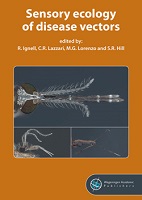Sensory Ecology of Disease Vectors

Contributor(s)
Ignell, R. (editor)
Lazzari, C.R. (editor)
Lorenzo, M.G. (editor)
Hill, S.R. (editor)
Language
EnglishAbstract
How do arthropods that transmit human pathogens perceive their world? The answer is essential for controlling the spread of vector-borne diseases in a rational way, and can help solve a major problem in current times. This state-of-the-art compendium, written for students and researchers in the Life Sciences, shows how these organisms use their sensory abilities to obtain and make use of cues and signals to find and discriminate among various resources.
‘Sensory Ecology of Disease Vectors’ covers diverse topics on a broad range of species. It provides a series of clear examples of how distantly related organisms, such as mosquitoes, ticks, kissing bugs, and flies, have solved similar problems to manage their needs for food, sexual partners, hiding places and where to lay their eggs.
‘Sensory Ecology of Disease Vectors’ brings together the combined knowledge and experience of researchers around the globe to offer novel perspectives on how arthropods use their senses to interact with their environment, and to our intense regret, us.
Keywords
sensory systems, resource seeking, communication, attraction, repellents, mosquitoes, kissing bugs, ticks, sand flies; tsetse fliesDOI
10.3920/978-90-8686-932-9ISBN
9789086869329, 9789086863808Publisher
Wageningen Academic PublishersPublisher website
https://www.wageningenacademic.com/Publication date and place
Wageningen, 2022Classification
Diseases and disorders
Zoology and animal sciences
